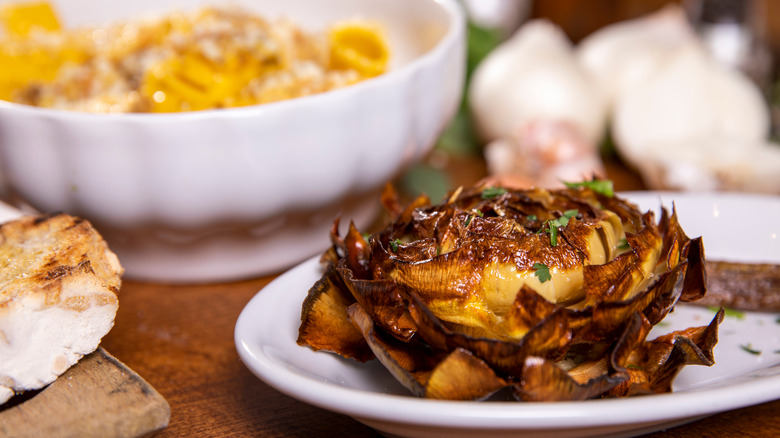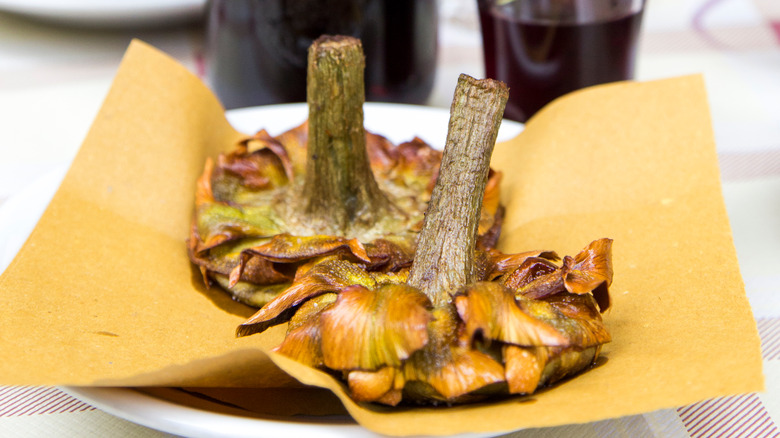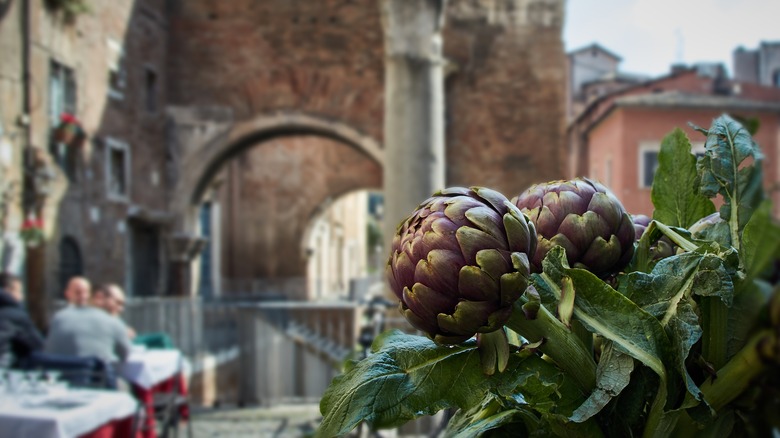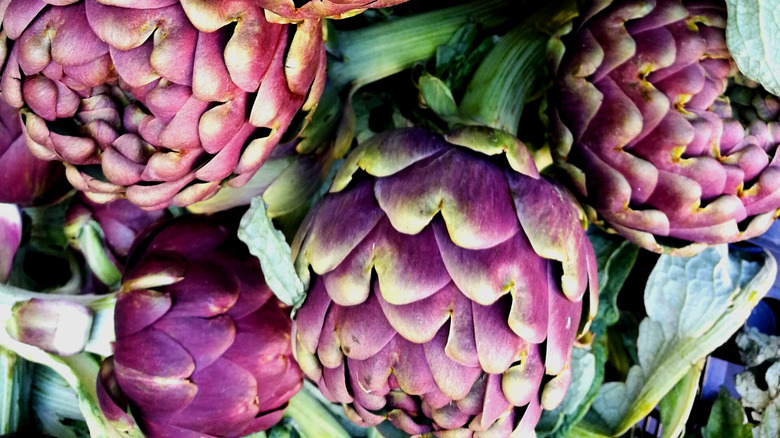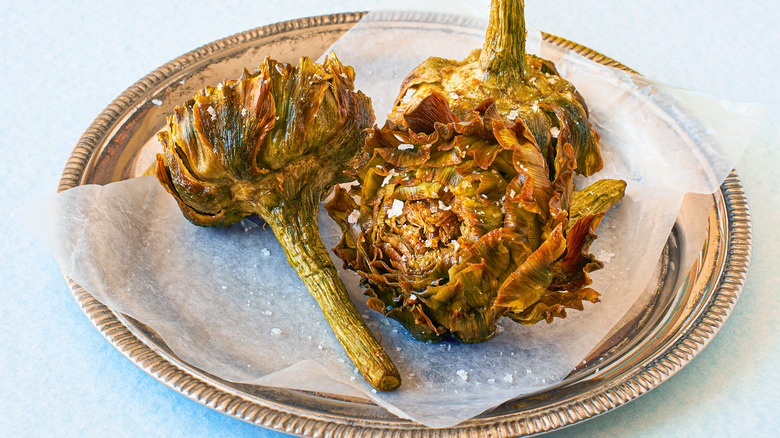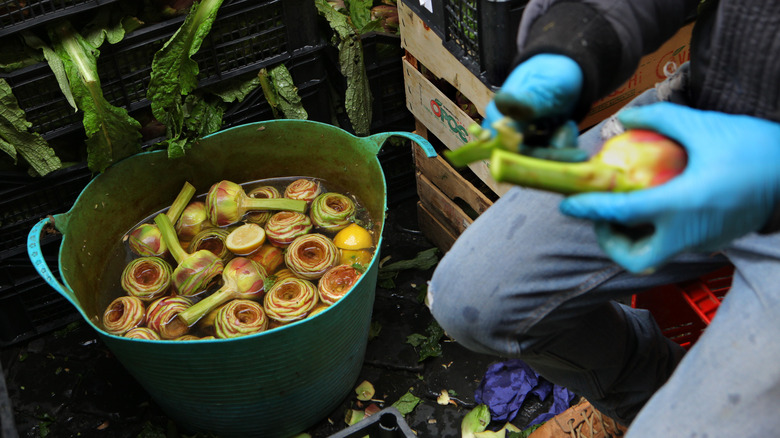Carciofi Alla Giudia: The Iconic Roman-Jewish Fried Artichoke Dish
Rome is often referred to as the "caput mundi," or the capital of the world, per Rerum Romanarum. While the Eternal City is no longer the global political powerhouse that it once was, it remains as one of the capitals of the culinary world. For example, Delicious Italy claims that any traveler going to Rome who wants to eat as well as the locals needs to sample at least two of the city's four musketeers of pasta. This includes cacio e pepe, carbonara, amatriciana, and alla gricia pastas.
Another great contribution that Roman chefs shared with the world is a love of artichokes. Falstaff states that the artichoke is "one of the cornerstones of Roman cuisine," and fills menus and markets every Spring during its harvest. The city even has its own style of artichoke named after it, the carciofi romaneschi, which Annie's Annuals describes as being large with a purple tint added to the usual deep greens of the beloved edible thistle. It forms the centerpiece of Roman dishes like Carciofi alla romana, and its deep-fried cousin, the carciofi alla giudia, which translates to "Jewish-style artichokes." This unique recipe was originally developed in Rome's historic Jewish Quarter but persists today as one of the city's most desirable dishes (per Falstaff).
What is carciofi alla giudia?
Devour Tours states that carciofi alla giudia is a dish that brings out the best qualities of Roman artichokes by giving them a bath in hot oil and a simple dressing of salt and pepper to complement their natural flavors without overpowering them. The artichokes are traditionally opened up while they are fried, which gives them the appearance of a flower in full bloom. This adds to their seasonal appearance on Springtime dining tables when harvested.
The crisp outer leaves are usually eaten first, and the tender heart and stem are left for the end, per Devour Tours. This creates a delicious contrast of textures as the diners progress through the dish. The Daily Beast notes that the stem, or gambo, is inedible on most artichokes, but on Roman artichokes, it serves as the delicious final highlight of the dish. Falstaff states that in restaurant kitchens, the artichokes are typically prefried to expedite the cooking process later, but plenty of home chefs simply give it a single deep fry instead.
History of carciofi alla giudia
As its name implies, carciofi alla giudia was originally created by Rome's Jewish population. According to My Jewish Learning, in 1555, Roman Jews were forced by Pope Paul IV to live inside of a walled ghetto. This Jewish ghetto (which was later known as the Jewish Quarter, per Rick Steves), and many of the related segregationist practices associated with it, weren't abolished until the 19th century. By then, Rome's Jewish population developed its own entirely unique culture (per My Jewish Learning).
The Daily Beast reports that fried artichokes were one of the products of this new culture. At that time, artichokes were looked down upon as food, meaning that there was an abundance remaining to be easily purchased by members of the Jewish community. This led to the creation of artichokes that were deep-fried in oil.
NPR points out that it was common for fried vegetables, likely including artichokes, to be sold by vendors known as friggitori in the Jewish Quarter. Jewish religious and culinary traditions also intersect every year during Hanukkah. Different deep-fried foods like latkes take on a symbolic meaning at this time of year. The oil used in their cooking is symbolic of the holiday's origins when a limited supply of consecrated oil lit the temple lamps for eight days.
Ingredients
One of the main keys to making this delicious fried treat is using the right artichokes. Unfortunately, this is one recipe you won't be able to sub in canned artichokes for. Devour Tours recommends using Roman artichokes for this recipe. This is because every part of the artichoke is edible, making it well-suited for frying whole. This is a huge contrast to the more common globe variety, which NPR points out requires its own technique to properly devour. According to Serious Eats, you don't even have to worry about removing the harmful choke from the Roman variety. It still has its own cleaning and trimming required, but it isn't as painstaking as other varieties.
The only other ingredient needed for this simple dish is a preferred frying oil. Serious Eats states that the right oil comes down to what kind of flavor you're hoping to achieve. The publication explains that using a neutral oil like vegetable or canola oil will allow more of the artichoke's natural flavor to come through. Using olive oil, on the other hand, will lend more of its own flavor instead. Giallo Zafferano also notes that you'll need an oil that can safely maintain a high cooking temperature and states that peanut oil is the best for the job.
Nutrition facts
Artichokes are well-regarded for their nutritional benefits. According to Healthline, artichoke extract has even become a popular health supplement due to its many valuable nutrients. Artichokes are a good source of vitamins C and K, contain numerous minerals, and have some of the highest antioxidant content among vegetables. They are also extremely high in fiber content. Artichokes have even been shown to improve liver and digestive health and symptoms related to irritable bowel syndrome. There might be some variations of these nutrients between artichoke varieties, but they're certainly not lacking in nutrition.
Where this dish does run into nutrition challenges, though, is its deep-fried nature. FitDay points out that many of those benefits are thrown out the window when food is prepared this way. The high temperature of the oil tends to cook off many of the nutrients. Foods also tend to take on more calories and fats when they're submerged in hot oil. GoodRx Health adds that fried foods tend to be high in saturated and trans fats. Regular consumption may lead to heart problems over a long-term period.
While artichokes are normally considered a nutrient-dense food, because carciofi alla giudia is fried, many of its benefits may not be present.
How to prepare carciofi alla giudia
Besides cleaning the extraneous bits of artichoke, preparing carciofi alla giudia is a fairly simple process. Giallo Zafferano explains that the first step is to clean the artichokes. Because this recipe calls for Roman artichokes, this will be less intensive than using globe artichokes, which requires the removal of the dangerous choke. Simply cut off the hard end of the stem and darker outer leaves until the most tender and light-colored leaves remain. Then strike the artichokes on your cutting board a few times to loosen the leaf cluster and spread them apart.
Meanwhile, heat your cooking oil to 350 degrees F in a saucepan. Place the interior of the artichoke into the pan and press down firmly by the stem to ensure it makes sufficient contact with the oil. Bon Appétit points out that it is necessary to hold the artichokes in place by their stalks for about 15 seconds in order for them to hold their shape. Once the leaves have all cooked completely, turn the artichoke on its side to cook the stem. Once tender, transfer the artichokes to a paper towel-lined plate and season with salt.
It should be noted that carciofi alla giudia are sometimes twice cooked, though it comes down to personal preference. Serious Eats recommends using a double-fried method to ensure a tender center and crispy exterior. However, Bon Appétit prefers to blanche them in water before frying.
